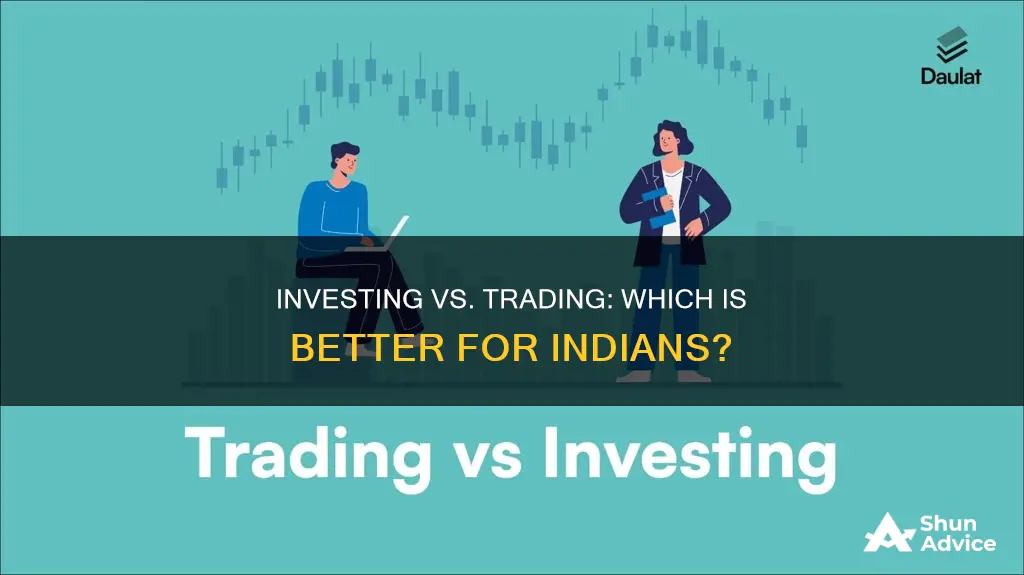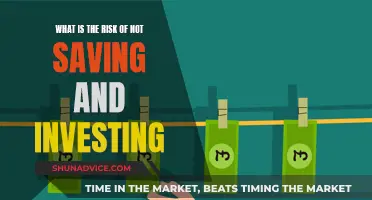
Investing and trading are two distinct ways to profit from the financial markets. While investing is buying and holding stocks for the long term, trading involves buying and selling stocks frequently to profit from short-term price changes. Both methods aim to increase an individual's wealth, but they differ in terms of timeline, mindset, and level of involvement. So, which is better for individuals in India? This is a complex question and depends on various factors, including risk appetite, time commitment, and understanding of the market.
What You'll Learn

Trading requires constant vigilance of market movements
Trading requires a great deal of vigilance and market understanding. It is a short-term game, and traders need to be constantly vigilant of market movements to profit successfully. This means keeping a close eye on market data, news, and trends to make informed decisions.
Traders need to be able to analyse and predict market changes and other traders' psychology in the short term. They must be able to dedicate the time and effort to research and understand the markets, which can be challenging for those with limited free time.
Traders also need to be able to make quick decisions and take action. They buy and sell stocks and other financial assets frequently, sometimes multiple times a day, to profit from price fluctuations. This active approach requires a good understanding of how the markets work and the ability to keep emotions in check, as big losses can be difficult to swallow.
Traders often use technical analysis tools, such as moving averages and stochastic oscillators, to identify high-probability trading setups. They also employ strategies like stop-loss orders to automatically close out losing positions and limit potential losses.
The short-term nature of trading means that traders' capital is not tied up in a stock for an extended period, reducing their market risk exposure. However, it also means that they may need to pay more in taxes, as profits on investments held for less than a year are typically taxed at a higher rate than long-term capital gains.
Overall, trading requires a significant time investment and a strong understanding of the markets and one's own risk tolerance. It is a high-risk, high-reward activity that demands constant vigilance and quick decision-making to profit from short-term market movements.
Diversifying Your Portfolio: Strategies for Investment Options
You may want to see also

Investors can benefit from compounding or reinvesting profits
Investing and trading are two different methods used to profit in the financial markets. While investors generally seek larger returns over an extended period through buying and holding, traders take advantage of rising and falling markets to enter and exit positions over a shorter time frame, taking smaller, more frequent profits.
Compounding is the process in which an asset's earnings, from either capital gains or interest, are reinvested to generate additional earnings over time. This growth occurs because the investment will generate earnings from both its initial principal and the accumulated earnings from preceding periods.
Compounding differs from linear growth, where only the principal earns interest each period. Compounding is often referred to as "interest on interest" or the "miracle of compounding".
How Compounding Works
Suppose you invest Rs 10,000 at an annual return of 8%. In the first year, your investment would grow by Rs 800, reaching Rs 10,800. However, instead of withdrawing the Rs 800 profit, you reinvest it. In the second year, your investment would increase by 8% of Rs 10,800, amounting to Rs 864. This process continues, and your money multiplies due to the increasing base amount. Over time, compounding can significantly boost your investment returns.
Benefits of Compounding Over Time
- Higher growth: When you reinvest your earnings, your original investment and the accumulated returns generate additional gains. As a result, your investment has the potential to grow at an accelerated rate, allowing your wealth to increase significantly in the long run.
- Wealth preservation: Compounding at higher rates helps combat the impact of inflation, ensuring that your wealth retains its purchasing power over time.
- Comfortable goal achievement: With the compounding booster, you can achieve your financial goals more comfortably, or even accumulate more than you require and create a cushion.
Strategies for Maximising the Power of Compounding
- Investing early and regularly: The power of compounding thrives on time, so the earlier you start investing, the longer your money has to grow. Making regular contributions further enhances the compounding effect by consistently adding to the principal amount.
- Reinvesting dividends and capital gains: When you invest in assets such as stocks or mutual funds, you often earn dividends and capital gains. By reinvesting these earnings rather than withdrawing them, you can amplify the compounding effect and significantly enhance your overall returns.
- Choosing investments with high growth potential: Selecting investments with high growth potential, such as stocks or mutual funds with a history of strong growth, can lead to substantial returns over time.
The combination of these strategies can create a compounding snowball effect, generating significant wealth over the long term. It is important to remember that compounding is a long-term strategy, and patience and discipline are key to reaping its full rewards.
Protecting Managed Investments: Strategies to Prevent Fraud
You may want to see also

Traders can profit from a sinking market
While investors tend to take a long-term approach, traders can profit from sinking markets by taking advantage of both rising and falling markets to enter and exit positions over a shorter time frame. Traders will attempt to make transactions that can help them profit quickly from fluctuating markets.
- Short-selling: The traditional method involves borrowing a share or another asset from your broker and selling it at the current market price. If the market does have a sustained period of downward movement, you can buy the shares back at a lower price at a later date and return them to the lender, keeping the difference as profit. However, if the market rises, you would have to buy the shares back at a higher price, potentially making a loss.
- Short-selling with derivatives: Derivatives are purely speculative and take their price from the underlying market price. When trading derivatives, you can always go long and short, so you can take advantage of markets that fall in price, as well as those that rise.
- Short exchange-traded funds (ETFs): A short ETF, or inverse ETF, is designed to profit when the underlying benchmark declines. These are commonly used by investors to hedge their share portfolio against short-term declines.
- Trading safe-haven assets: A safe-haven asset is a financial instrument that typically retains its value or increases in value when the broader market declines. Common examples include gold, government bonds, the US dollar, the Japanese yen, and the Swiss Franc.
- Going long on defensive stocks: Defensive stocks are shares of companies that are perceived as consumer staples, so their products are needed regardless of the state of the economy, such as food and beverage producers and utility companies.
- Choosing high-yielding dividend shares: While growth stocks tend to suffer most in bearish markets, dividend stocks can be a great way to find value in a declining market.
Investing vs. Trading in India
While there is no one-size-fits-all answer to whether investing or trading is better, there are some key differences between the two strategies that can help you decide which is better for you.
Investing
- Takes a long-term approach, often for retirement accounts
- Buys and holds a portfolio of assets for years or decades
- Aims for larger returns over an extended period
- Less time-intensive
- More suitable for those who are risk-averse and want to preserve their capital
Trading
- Takes advantage of short-term strategies to maximise returns daily, monthly, or quarterly
- Entails more frequent transactions, such as buying and selling stocks, commodities, or currencies
- Aims for smaller, more frequent profits
- More time-intensive, requiring consistent monitoring of the markets and a good understanding of how they work
- More suitable for those who have a good grasp of the markets and are more risk-tolerant
Ally Invest Trade Times in Managed Portfolios
You may want to see also

Investors are more likely to ride out short-term losses
Investors are more concerned with the long-term trajectory of the company and its fundamentals, such as price-to-earnings (P/E) ratios and management forecasts. They are willing to wait patiently as their investments grow and are unfazed by short-term negative market reactions, such as quarterly earnings announcements.
In contrast, traders tend to have a short-term orientation, aiming to profit from fluctuating markets. They focus on the performance of the stock rather than the underlying business and are more likely to be influenced by the actions of other players in the market. Traders are also more likely to incur higher taxes as they realise profits more frequently, whereas investors benefit from compounding at a higher rate by deferring taxes until they sell their investments.
The distinction between the two strategies can be summed up as follows: "With trading, you make money by acting; with investing, you make money by waiting."
Investment Managers: Crafting Your Portfolio for Success
You may want to see also

Trading stocks is expensive
Trading stocks can be expensive due to the high costs and inefficiencies associated with it. Here are some reasons why trading stocks can be costly:
Trading is a Zero-Sum Game:
Trading operates on the principle of a zero-sum game, where one person's gain comes at the expense of another's loss. This is unlike investing, which is a positive-sum game where multiple individuals can benefit from the success of a business over time. In trading, the sharpest players accumulate wealth by taking advantage of less adept players, making it a costly endeavour for those who are not as skilled or experienced.
Missing Out on the Best Days:
Traders who frequently enter and exit the market are at risk of missing out on the market's biggest gains. Historical data shows that staying invested through the best days in the market can have a significant impact on overall returns. By attempting to time the market, traders may sacrifice the benefits of long-term compounding and end up with lower returns.
Increased Tax Liability:
Frequent trading activity results in higher tax liabilities. Each time a trader realises a profit by selling an asset, they incur taxes on those gains. This reduces their ability to compound their returns over time. In contrast, investors who hold onto their investments for longer periods can defer taxes and compound their returns at a higher rate.
Time and Effort:
Trading requires a significant amount of time and effort. Successful traders need to consistently monitor the markets, conduct research, and make frequent buying and selling decisions. This active approach demands a deep understanding of the markets and can be emotionally challenging, especially when dealing with significant losses.
Short-Term Focus:
Traders focus on short-term price movements and aim for quick profits. This approach can lead to higher transaction costs and may result in suboptimal decisions driven by short-term market noise rather than the long-term fundamentals of a business.
Portfolio Investment: A Long-Term Financial Journey
You may want to see also
Frequently asked questions
The main difference lies in the timeline. Investing typically involves holding onto an asset for years or decades, whereas trading involves buying and selling assets within a shorter time frame, such as days, weeks, or months.
Investing is generally considered more suitable for beginners as it requires less frequent transactions and can be a more passive approach to growing one's wealth. Trading, on the other hand, requires more time and effort, as well as a better understanding of the markets and how different assets work.
Investing has several advantages, including the power of compounding, dividend income, and the ability to be a passive source of income. Compounding allows investors to reinvest their profits and dividends to grow their wealth over time. Additionally, investing may be more tax-efficient as holding assets for the long term may result in lower capital gains taxes.







